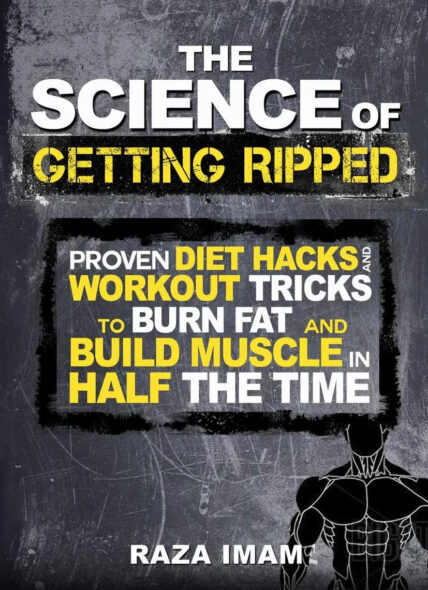STRENGTH SENSEI BOOKSHELF
The Science of Getting Ripped
The Science of Getting Ripped has two strikes against it. First, it lacks science. Second, the author, Raza Imam, is not an accomplished bodybuilder or personal trainer. Keeping an open mind, let’s get started.
Imam said that when he was in his 30s, he wanted to get back in shape. He was a busy family man, but his free time was minimal. He wanted to get ripped but found that all the workouts on getting ripped said he needed to train six days a week. So, he did a lot of research (despite having little free time?) and discovered that the key to getting ripped was not to train longer but to train longer with a “specific” type of workout. The result is this book with the subtitle: “Proven Workout Hacks and Diet Tricks to Burn Fat and Build Muscle in Half the Time.”

As for the science, Imam is a computer engineer and offered no academic credentials for being able to discuss this subject. He also apparently didn’t believe that providing references for his research was necessary. However, he did mention a self-help book by the late plastic surgeon Dr. Maxwell Maltz called “Psycho-Cybernetics,” which discussed achieving goals through visualization.
Charles R. Poliquin has shared many of the same goal-setting ideas Imam touches on in The Science of Getting Ripped. Two that they share are to determine specific goals and set deadlines. The Strength Sensei used the example of an athlete in a fighting sport who wants to move up a bodyweight class. This athlete could write their goal like this: “I want to add 10 pounds of lean muscle to compete in the 170-pound bodyweight division by June 10, 2023.”

To get ripped, Iman says you need the following two things (hope you’re sitting down): 1) Lose bodyfat, and 2) Build or maintain muscle mass.
Imam says to lose fat, consume fewer calories than you burn. He says if you regularly consume 2,000 calories a day, if you consume 200 calories fewer per day and you will somehow lose 1-2 pounds a week. (Do the math. 200 x 7 = 1400. A pound of fat contains about 3500 calories.) However, he warns that some of that weight loss may be muscle.
To gain muscle, consume more calories than you burn. He says if you burn 2500 calories a day and lift weights, consume an extra 200 calories a day, and you’ll pack on the mass! Stay with us here.
Iman says the secret to getting ripped is to alternate between workouts where you lift weights and days where you perform high-intensity cardio. On the days you lift, consume more carbs and less fat. On the days you do high-intensity cardio, consume more fat and fewer carbs. Do this six days a week. Unfortunately, Imam doesn’t advise us on what to eat on the rest day, but his general recommendation is to consume a diet of 30 percent protein, 30 percent fat, and 40 percent carbs.
As for the weight training workouts, move on – nothing special to see here. For example, he presents a program that alternates between doing 5×5 on the squat, bench press, and bent over row; with a program that has you do squats, overhead press, and deadlift. Rest 4-5 minutes between sets.
For the high-intensity cardio, he provided an example of doing a tri-set of burpees, running in place, and mountain climbers for 30 seconds for each exercise. Rest for one minute and repeat three times. Done!
Will someone benefit from following the workouts in The Science of Getting Ripped? Probably. But if you’re serious about getting ripped, look for other resources, beginning with the articles on the Strength Sensei website. (TSS)
[You can purchase The Science of Getting Ripped by Raza Imam in Kindle, paperback, and audiobook versions through Amazon.com.]
